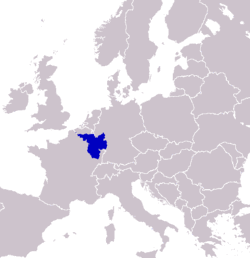SaarLorLux
|
SaarLorLux
Saar–Lor–Lux SarLorLux |
|
|---|---|

Emblem
|
|

Location and extent of SaarLorLux in western Europe.
|
|
| Type | Euroregion |
| Membership | |
| Establishment | 16 October 1980 |
| Area | |
|
• Total
|
65,400 km2 (25,300 sq mi) |
| Population | |
|
• 2006 estimate
|
11,330,944 |
|
• Density
|
173/km2 (448.1/sq mi) |
SaarLorLux or Saar-Lor-Lux (also SarLorLux in French), a portmanteau of Saarland, Lorraine and Luxembourg, is a euroregion of five different regional authorities located in four different European states. The term has also been applied to cooperations of several of these authorities or of their subdivisions, administrations, organisations, clubs and people. Member regions represent different political structures: the sovereign state of Luxembourg; Belgium's Walloon region, comprising the French and German speaking parts of Belgium; Lorraine, a region of France; the French départements Moselle and Meurthe-et-Moselle; and the German federal states of Saarland and Rhineland-Palatinate.
There is no well-defined structure of SaarLorLux nor even an exclusive definition of its size. Instead, there exist multiple forms of cooperation and contractual relations among all or several members. Sometimes instead of SaarLorLux, the term Greater Region is used, short for the more formal "Greater Region of Saarland, Lorraine, Luxembourg, Wallonia and (Western-) Rhineland-Palatinate".
The region of SaarLorLux was settled by the Celtic tribes of the Treveri and Mediomatrici. The Treveri lived in the south of Belgium, Luxembourg, western Rhineland-Palatinate, and northern Saarland. Lorraine and the southern Saarland were inhabited by the Mediomatrici. Both tribes were conquered during the Gallic Wars by the Roman legions of Julius Caesar. The area became part of the Roman provinces of Gallia Belgica, Germania Superior, and Germania Inferior.
...
Wikipedia
